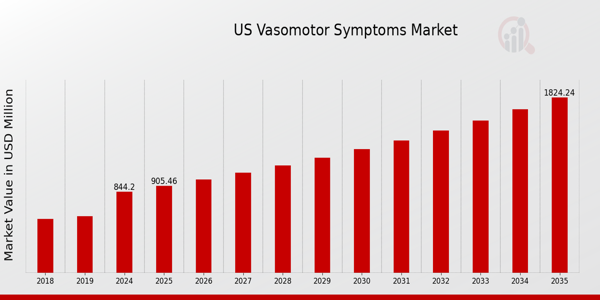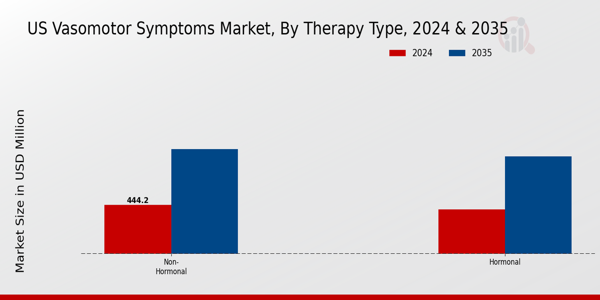US Vasomotor Symptoms Market Overview
As per MRFR analysis, the US Vasomotor Symptoms Market Size was estimated at 789.6 (USD Million) in 2023. The US Vasomotor Symptoms Market Industry is expected to grow from 844.2(USD Million) in 2024 to 1,824.2 (USD Million) by 2035. The US Vasomotor Symptoms Market CAGR (growth rate) is expected to be around 7.256% during the forecast period (2025 - 2035).
Key US Vasomotor Symptoms Market Trends Highlighted
The US Vasomotor Symptoms Market is experiencing a notable shift as awareness around menopause and its associated symptoms increases. With more focus on women's health issues, particularly following research and advocacy campaigns, there is a growing recognition of vasomotor symptoms, such as hot flashes and night sweats, which affect a significant portion of the female population nearing or experiencing menopause. This has driven demand for effective treatment options, which has prompted pharmaceutical companies to research and develop both hormone replacement therapies and non-hormonal alternatives to target these symptoms.
In recent times, there has also been a rise in preference for holistic and natural remedies, reflecting a broader trend in health and wellness. Many women are seeking non-invasive treatments such as herbal supplements, lifestyle changes, and alternative therapies, which provides an opportunity for companies to diversify their product lines to meet these preferences. Additionally, telehealth services are gaining traction, allowing women to consult healthcare providers from the comfort of their homes. This trend has been accelerated by the COVID-19 pandemic, underlining the need for accessible healthcare solutions in the US.
Furthermore, the increasing influence of social media and online communities has encouraged open discussions about menopause, leading to greater visibility and understanding of vasomotor symptoms. This cultural shift supports both market growth and the exploration of opportunities in education and support resources. In summary, the US market is poised for innovation and expansion as it adapts to changing consumer preferences, and increased awareness promotes better treatment options for vasomotor symptoms.

Source: Primary Research, Secondary Research, Market Research Future Database and Analyst Review
US Vasomotor Symptoms Market Drivers
Increasing Awareness of Vasomotor Symptoms
There is a growing awareness regarding vasomotor symptoms, especially among women undergoing menopause. Organizations such as the North American Menopause Society (NAMS) have been actively educating healthcare providers and the public about the implications of menopause-related symptoms, which affect approximately 80% of women at some point in their lives. This increased awareness is leading to more women seeking medical advice and treatment.
Moreover, public health campaigns have been conducted to highlight the impact of vasomotor symptoms on the quality of life, prompting discussions around management options. The US government also supports initiatives focusing on women's health, which is expected to bolster the US Vasomotor Symptoms Market Industry as healthcare providers are more equipped to address these symptoms, stimulating demand for treatment and care solutions.
Growing Demand for Hormone Replacement Therapy
The demand for Hormone Replacement Therapy (HRT) is on the rise in the United States, driven by an increasing incidence of vasomotor symptoms during menopause. According to the US Department of Health and Human Services, it is estimated that around 6,000 women enter menopause each day in the US. This translates to a significant number of women who may seek relief through HRT.
The American College of Obstetricians and Gynecologists supports this demand by recommending HRT as an effective treatment for severe symptoms, leading to wider acceptance and use of therapies in practice. With more healthcare providers offering HRT and the growing emphasis on effective symptom management, this trend contributes positively to the growth trajectory of the US Vasomotor Symptoms Market Industry.
Advancements in Treatment Options
Recent advancements in treatment options for vasomotor symptoms are also driving market growth in the US. Innovative therapies, including selective serotonin reuptake inhibitors (SSRIs) and newer non-hormonal treatments, are becoming more widely available. Clinical studies have shown that these alternatives can effectively manage symptoms for women who prefer to avoid traditional HRT, creating a more tailored approach to treatment.
Institutions such as the National Institutes of Health (NIH) are actively funding research into these new therapies, which has resulted in new FDA-approved options that enhance patient outcomes. As a result, the availability of these advanced treatment modalities is expected to further expand the US Vasomotor Symptoms Market Industry as healthcare providers consider various treatment regimens to best serve their patients.
Increased Healthcare Expenditure on Women’s Health
There has been a notable increase in healthcare expenditure targeting women's health issues in the United States. According to the Centers for Medicare and Medicaid Services, expenditures on women's health are projected to rise significantly in the coming years, reflecting broader societal recognition of women's health concerns, including vasomotor symptoms. This increase in funding is paving the way for improved access to care and treatment for women experiencing these symptoms.
Furthermore, health insurance plans are increasingly recognizing the necessity of covering treatments for menopausal symptoms, thereby reducing out-of-pocket costs for patients. This supportive healthcare landscape creates continued growth prospects in the US Vasomotor Symptoms Market Industry, providing more women with the resources they need to manage symptoms effectively.
US Vasomotor Symptoms Market Segment Insights
Vasomotor Symptoms Market Therapy Type Insights
The US Vasomotor Symptoms Market is experiencing notable growth, driven by the increasing prevalence of symptoms associated with hormonal changes, particularly during menopause. In this context, the Therapy Type segment is principally divided into two critical categories Hormonal and Non-Hormonal therapies. Hormonal therapies, which primarily involve the administration of estrogen, play a significant role in alleviating vasomotor symptoms such as hot flashes and night sweats.
These therapies are often considered the first line of treatment due to their efficacy in managing symptoms effectively. However, there are also concerns regarding the long-term safety and side effects associated with hormonal treatments, which opens up a growing market for Non-Hormonal therapies. Non-Hormonal alternatives, including selective serotonin reuptake inhibitors (SSRIs) and other medications, provide patients with viable options who may be at risk of adverse effects from hormone therapy or who prefer to abstain from hormonal treatments altogether.
This dynamic creates a diversified approach to treatment within the market. With new research and developments continually emerging, the adoption rate of both Therapy Types is influenced by patient preferences and clinical recommendations. The rising awareness of menopause and its associated symptoms has led to increased demand for effective treatment options, resulting in a robust growth in the US Vasomotor Symptoms Market.
Moreover, this segment benefits from an emphasis on personalized medicine, allowing for tailored treatment regimens based on individual patient needs and medical history. The integration of technology, such as telehealth services, further enhances patient access to treatments, making it easier to obtain necessary prescriptions or consultations. As a result, both Hormonal and Non-Hormonal therapies are crucial in addressing the needs of women experiencing vasomotor symptoms, ensuring a comprehensive approach to management and treatment in a rapidly evolving market landscape.

Source: Primary Research, Secondary Research, Market Research Future Database and Analyst Review
Vasomotor Symptoms Market Distribution Channel Insights
The Distribution Channel segment of the US Vasomotor Symptoms Market is crucial, encompassing various avenues through which products reach consumers. Hospital pharmacies play a significant role in ensuring that patients undergoing treatment for vasomotor symptoms receive medications quickly and efficiently, serving as a vital touchpoint for prescription management.
Retail pharmacies provide convenience and accessibility to the general public, often being the first point of contact for patients seeking relief from symptoms associated with menopause. The rise of online stores is transforming the marketplace, catering to the growing trend of e-commerce where patients can discreetly acquire products from the comfort of their homes.
This shift towards online purchasing is driven by increased internet penetration and the growing preference for convenience among consumers. Overall, each distribution channel holds distinct importance in the US Vasomotor Symptoms Market, contributing to a balanced and comprehensive approach that enhances product availability and patient access, aligning with broader trends in the healthcare industry towards improved patient-centric service delivery.
US Vasomotor Symptoms Market Key Players and Competitive Insights
The competitive landscape of the US Vasomotor Symptoms Market is characterized by a dynamic interplay of innovation, strategic alliances, and market expansion efforts by key players. This market segment, primarily driven by the demand for effective treatments for symptoms associated with menopause, has attracted significant attention from pharmaceutical companies looking to enhance their product offerings.
The presence of well-established organizations alongside emerging companies has led to a diverse range of therapies being developed to address the variegated needs of patients experiencing vasomotor symptoms. Analysis of this competitive environment reveals trends in product development, regulatory approvals, and market penetration strategies that are shaping the evolution of the sector in the United States.
Key Companies in the US Vasomotor Symptoms Market Include
US Vasomotor Symptoms Market Industry Developments
The US Vasomotor Symptoms Market has seen significant recent activity, particularly regarding advancements and partnerships among leading pharmaceutical companies. Bristol Myers Squibb, AstraZeneca, Novartis, and others are noted for their ongoing Research and Development efforts, targeting innovative treatments for menopausal symptoms.
In August 2023, Merck announced a strategic collaboration with Horizon Therapeutics, focusing on an emerging treatment that aims to alleviate vasomotor symptoms associated with menopause. Additionally, Eli Lilly has expanded its product portfolio with a new formulation aimed at reducing hot flashes, securing a competitive edge in the market.
There have also been reports of industry growth, driven by increased awareness and diagnosis of vasomotor symptoms, with the market valuation expected to exceed $4 billion by 2025. Significant occurrences from the past few years include Sanofi's acquisition of a portfolio from another pharmaceutical company in May 2022, enhancing its position in this niche therapeutic area.
The ongoing regulatory support from the Food and Drug Administration encourages innovation, prompting companies like Pfizer and Amgen to invest further in the landscape. Overall, the market shows robust potential, influenced by strong corporate investments and increasing patient demand.
US Vasomotor Symptoms Market Segmentation Insights
Vasomotor Symptoms Market Therapy Type Outlook
Vasomotor Symptoms Market Distribution Channel Outlook
| Report Attribute/Metric Source: |
Details |
| MARKET SIZE 2018 |
789.6(USD Million) |
| MARKET SIZE 2024 |
844.2(USD Million) |
| MARKET SIZE 2035 |
1824.2(USD Million) |
| COMPOUND ANNUAL GROWTH RATE (CAGR) |
7.256% (2025 - 2035) |
| REPORT COVERAGE |
Revenue Forecast, Competitive Landscape, Growth Factors, and Trends |
| BASE YEAR |
2024 |
| MARKET FORECAST PERIOD |
2025 - 2035 |
| HISTORICAL DATA |
2019 - 2024 |
| MARKET FORECAST UNITS |
USD Million |
| KEY COMPANIES PROFILED |
Bristol Myers Squibb, AstraZeneca, Novartis, Merck, Eli Lilly, HoffmannLa Roche, Horizon Therapeutics, Pfizer, Amgen, AbbVie, Sanofi, Johnson and Johnson, GSK, Mylan, Teva Pharmaceuticals |
| SEGMENTS COVERED |
Therapy Type, Distribution Channel |
| KEY MARKET OPPORTUNITIES |
Telehealth vasomotor management programs, Hormone therapy innovations, Non-hormonal treatment advancements, Personalized medicine approaches, Increased awareness and education efforts |
| KEY MARKET DYNAMICS |
increasing menopausal population, growing awareness and education, emergence of novel therapies, expanding telehealth services, rising demand for personalized treatment |
| COUNTRIES COVERED |
US |
Frequently Asked Questions (FAQ):
The US Vasomotor Symptoms Market is expected to be valued at 844.2 million USD in 2024.
By 2035, the market is projected to reach a value of 1824.2 million USD.
The expected CAGR for the US Vasomotor Symptoms Market from 2025 to 2035 is 7.256%.
The two main therapy types in the US Vasomotor Symptoms Market are Hormonal and Non-Hormonal.
The market size for Hormonal therapy is valued at 400.0 million USD in 2024.
The market size for Non-Hormonal therapy is expected to be 944.2 million USD by 2035.
Key players in the US Vasomotor Symptoms Market include Bristol Myers Squibb, AstraZeneca, Novartis, and Merck.
The market presents significant growth opportunities driven by increasing awareness and treatment options for vasomotor symptoms.
Emerging trends in personalized medicine and non-hormonal treatment options are expected to influence the market positively.
Challenges include regulatory hurdles and competition among the major pharmaceutical companies.
















